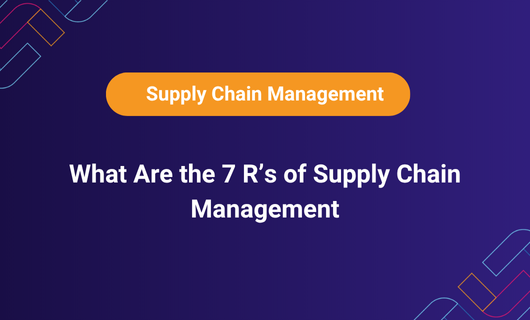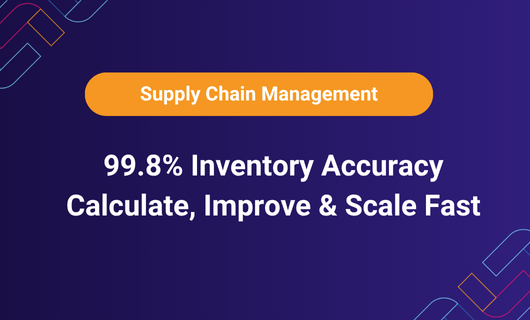Are You Struggling to Scale Your E-commerce Supply Chain?
Your growth on Amazon or DTC could be hitting a ceiling. Why? Inefficient operations, inventory mismanagement, or outdated tools. That’s where understanding the 7 R’s of supply chain management—with Brankit’s powerful toolkit—comes in.
Let’s decode them with real-world e-commerce scenarios.
What Are the 7 R’s of Supply Chain Management?
These seven principles ensure that your product reaches the right customer, at the right time, in the proper condition, with the correct documentation, from the right source, in the correct quantity, and at the right cost.
Here’s a quick infographic list of the 7 R’s:
| Principle | E-commerce Example |
| Right Product | Stocking trending electronics via Brankit |
| Right Customer | Personalized fulfillment for Amazon buyers |
| Right Time | Avoiding OOS during Black Friday |
| Right Condition | No damaged returns with tracked QC |
| Right Quantity | Inventory KPIs showing demand spikes |
| Right Place | Fulfillment routed to nearby warehouses |
| Right Cost | Optimized pricing through supply chain analytics |
Mastering Each R with E-commerce Examples
1. Right Product: Inventory Planning Made Simple
Use tools like Brankit to align demand forecasting with top-selling SKUs. Brands like Allbirds rely on trend analysis to stock only relevant products.
Tool: E-commerce inventory tools + supply chain analytics software solutions
2. Right Customer: Personalized Ecommerce Fulfillment
Supply chain software solutions segment customers by region, behavior, and buying frequency. Brands like Glossier use this to tailor fulfillment.
Tool: Supply chain collaboration software solutions
3. Right Time: Real-Time Data for Real-Time Demand
Peak season coming? Brankit’s predictive tools prevent stockouts by instantly adjusting forecasts.
Used by: Amazon sellers during Prime Days
4. Right Condition: Automated QC Tools
You don’t want damaged packages arriving at your customer’s doorstep. Ensure quality checks at every fulfillment node.
Tool: Supply chain software solutions with real-time damage alerts
5. Right Quantity: Inventory KPIs Done Right
Brankit lets brands like Gymshark balance minimum stock levels with seasonal demand. Inventory KPIs monitor sell-through rates vs restocks.
Tool: E-commerce inventory management services + inventory KPIs dashboards
6. Right Place: Fulfillment Routing by Zip Code
Using geo-analytics, Brankit auto-assigns the best fulfillment center, closer to the buyer.
Example: Amazon’s local warehouse strategy simplified
7. Right Cost: Cost Optimization = Higher Profits
Avoid unnecessary storage or emergency shipping fees. Brankit utilizes supply chain and data analytics to strike a balance between cost efficiency and service.
Result: Brands like Brooklinen improved margin per SKU
Solution: Request a Demo of the Brankit Platform
Your All-in-One Supply Chain Software Solution for E-commerce
- Boost visibility across Amazon & Shopify
- Get real-time analytics & SKU-level performance
- Forecast demand & prevent stockouts
- Collaborate with suppliers, track POs
Side-by-Side – Supply Chain vs Value Chain in E-commerce
| Feature | Supply Chain | Value Chain |
| Focus | Operations | Value Creation |
| Tools | Inventory & fulfillment | Branding, marketing, and UX |
| Example | Brankit SCM dashboard | Amazon storefront UX |
| Goal | Efficiency | Differentiation |
Brankit Helps Top E-commerce Brands Like:
- Amazon FBA sellers with multi-region supply chain needs
- Casper with supply chain consulting company guidance
- Warby Parker optimizing inventory KPIs & shipping cost
Final Thoughts: Scale with Smart Supply Chain Tools
Supply chain success isn’t just logistics. It’s innovative systems, integrated tools, and data-led decisions. Brankit provides Amazon and DTC brands with the tools they need to succeed in a crowded market.
FAQs (People Also Ask)
1. What are the 7 Rs of supply chain management in e-commerce?
They represent the seven essential goals: product, customer, time, condition, quantity, place, and cost.
2. What’s the difference between the value chain and supply chain in e-commerce?
The value chain adds competitive value (UX, branding), while the supply chain focuses on efficiently delivering products to customers.
3. Which KPIs are used for inventory in the supply chain?
Turnover rate, carrying cost, sell-through rate, and backorder rate are common inventory key performance indicators (KPIs).
4. What tools are best for inventory management in e-commerce?
Brankit, Skubana, and Zoho Inventory offer real-time analytics and demand forecasting.
5. Are supply chain software solutions different from ERP?
Yes. ERP covers internal operations; SCM focuses on product flow across multiple vendors.
6. How can I automate my e-commerce inventory?
Use tools like Brankit to integrate forecasting, alerts, reordering, and analytics.
7. What is supply chain analytics software used for?
To uncover patterns, reduce costs, and improve supply chain performance using big data.
8. What are the benefits of supply chain consulting firms for Amazon sellers?
They offer strategy, audits, and platform-specific guidance to improve fulfillment, profitability, and ratings.
9. How do supply chain specialists support DTC brands?
They help with network design, forecasting, and warehouse optimization.
10. Can Brankit help with multi-channel e-commerce supply chain management?
Yes! Brankit syncs your inventory across multiple platforms, including Amazon, Shopify, Walmart, and more.





